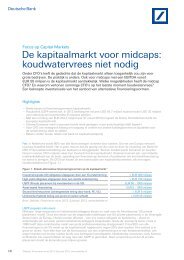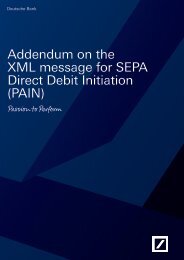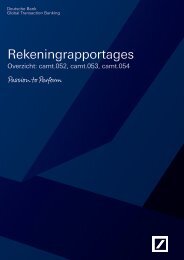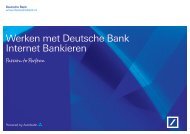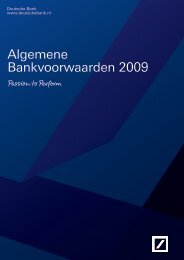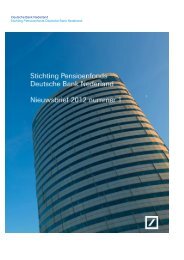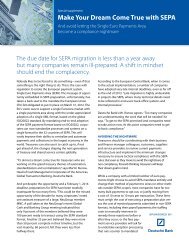GCC financial markets - Deutsche Bank Research
GCC financial markets - Deutsche Bank Research
GCC financial markets - Deutsche Bank Research
You also want an ePaper? Increase the reach of your titles
YUMPU automatically turns print PDFs into web optimized ePapers that Google loves.
<strong>GCC</strong> <strong>financial</strong> <strong>markets</strong>Credit growth 4Credit continues to grow...6005004003002001000-10090 92 94 96 98 00 02 04 06 08 10AE BH KW OM QA SA... albeit at considerably reduced rates8060402001000-100-200-20-30000 02 04 06 08 10AEBHKWOMQASA (right)Note: Top - Total credit, net, USD bn. Bottom - Net creditgrowth, % p.a.Sources: IIF, DB <strong>Research</strong>Sobered-out stock <strong>markets</strong> 5Market capitalisation700600500400300200100000 01 02 03 04 05 06 07 08 09 10 11Market turnover35030025020015010050000 01 02 03 04 05 06 07 08 09 10 11AE BH KWOM QA SANote: Market capitalisation on national stock <strong>markets</strong>, USDbn. Stock market turnover ratio, total value of shares tradedin % of average market capitalisation.Sources: World <strong>Bank</strong>, DB <strong>Research</strong>recovery of bank balance sheets cannot be expected before a solid recoverytakes hold especially in the real estate and corporate sector. In the same vein,provisioning requirements remain high, and bank profitability continues to beunder pressure.Net credit volume in the <strong>GCC</strong> as a whole had continued to grow steadily, albeitsomewhat more slowly since the onset of the crisis and with considerablevariations across the six member states. As corporate and retail loan demandhas fallen and bank risk aversion intensified, especially Saudi Arabia and theEmirates have seen new credit volumes reduced. Throughout the <strong>GCC</strong> arebound of credit provision is expected to depend critically on future governmentspending to stimulate private consumption and corporate investment as well asthe speed of the economic recovery.Stock <strong>markets</strong>In response to the crisis, <strong>GCC</strong> stock <strong>markets</strong> had collapsed by between one-fifthand two-thirds between early 2007 and the respective trough in late 2008. Thiscompares with an almost 50% decline of the S&P 500 and the MSCI EmergingMarkets Index, suggesting that most <strong>GCC</strong> stock <strong>markets</strong> had performed betterthrough this period, with Dubai’s decline by more than two-thirds as the mostnotable exception.Since the critical phase of the <strong>financial</strong> crisis, <strong>GCC</strong> stock <strong>markets</strong> performancehas diverged sharply, with Dubai, Bahrain and Kuwait at historically low levels ofjust over 50% of their index values immediately prior to the crisis. Oman, SaudiArabia and Abu Dhabi, in contrast, have recovered to 80% to 90% of their precrisisindex levels, in line with the S&P 500 in the US. However, even therebound in these three <strong>markets</strong> has been too weak to keep up with the pace inother emerging stock <strong>markets</strong> where price levels had risen to 15% above precrisislevels.In line with price developments, the value of firms listed on <strong>GCC</strong> stockexchanges has declined drastically compared with immediate pre-crisis levels.With the exceptions of Bahrain, Qatar and Oman, where capitalisation was closeto pre-crisis levels or even higher by end-2010, all other stock <strong>markets</strong> continueto suffer from low market capitalisation comparable to the valuations seen in theearly phases of <strong>GCC</strong> <strong>financial</strong> market development around 2004. Marketturnover, too, has remained sluggish.Bond <strong>markets</strong><strong>GCC</strong> bond <strong>markets</strong>, whether public or private, have not enjoyed a similardynamism in their development as observed in other market segments over thepast decade. Their heterogeneous development was in most economiesinterrupted by the <strong>financial</strong> crisis, but issuance activity revived in 2009 and2010. In Bahrain, Qatar, and the Emirates, where bond <strong>markets</strong> have actuallygrown to significance over the past years, bond trading continued to growthroughout the crisis, and based on data for the first half of the year, 2011 mayagain have seen an increase in market activity.Taking Bahrain as an example, new issuance focussed on regular Treasury Billissuances as well as discretionary sales of government Development Bonds.Use of Islamic debt instruments by the government expanded, too, andtraditionally makes up the largest portion of debt outstanding.Discussions over greater emphasis on the development of local bond <strong>markets</strong>have been reignited by the crisis. As the largest part of government debt isissued as USD-denominated international bonds, placement turned out to beparticularly challenging when international <strong>markets</strong> dried out and bank liquidity5 | November 14, 2012 Current Issues




